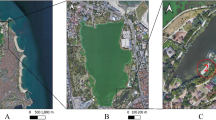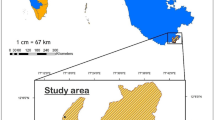Abstract
Like many invasive species, cane toads (Rhinella marina) in Australia concentrate in the disturbed habitats created by human activity, rather than in pristine areas. We surveyed cane toads in the wet–dry tropics of the Northern Territory to assess the abundances, body sizes, sexes, behaviour, hydration state and feeding rates of toads around buildings compared to those in areas remote from buildings, and conducted experimental trials to assess the effects of building-related variables (lights and increased toad densities) on the foraging success of toads. Toads around buildings were smaller than bushland conspecifics, and adult sex-ratios were female-biased. Toads were more sedentary around buildings than in the bush, but their feeding rates (based on direct observations and faeces production post-capture) were similar. That similarity, despite twofold-higher densities of competing toads around building, reflected the strong enhancement of feeding rates due to artificial lights attracting insects (in our experimental trials, a threefold increase regardless of the number of competing toads). Toads collected from around buildings were apparently in better hydric condition. Thus, access to water also may attract toads to buildings. The relative scarcity of adult male toads around buildings likely reflects waterbody-centred reproductive activities, whereas the concentration of females and juveniles around buildings is driven largely by access to the insects attracted by artificial light. We conclude that buildings enhance the persistence of cane toad populations and may facilitate their spread.




Similar content being viewed by others
References
Brown GP, Shine R (2007) Rain, prey and predators: climatically driven shifts in frog abundance modify reproductive allometry in a tropical snake. Oecologia 154:361–368
Brown GP, Phillips BL, Webb JK, Shine R (2006) Toad on the road: use of roads as dispersal corridors by cane toads (Bufo marinus) at an invasion front in tropical Australia. Biol Conserv 133:88–94
Brown GP, Kelehear C, Shine R (2011) Effects of seasonal aridity on the ecology and behaviour of invasive cane toads in the Australian wet–dry tropics. Funct Ecol 25:1339–1347
Carey C (1978) Factors affecting body temperatures of toads. Oecologia 35:197–219
Child T, Phillips BL, Brown GP, Shine R (2008) The spatial ecology of cane toads (Bufo marinus) in tropical Australia: Why do metamorph toads stay near the water? Austral Ecol 33:630–640
Child T, Phillips BL, Shine R (2009) Does desiccation risk drive the distribution of juvenile cane toads (Bufo marinus) in tropical Australia? J Trop Ecol 25:193–200
Christensen CU (1974) Adaptations in the water economy of some anuran amphibia. Comp Biochem Phys A Physiol 47:1035–1049
Colunga-Garcia M, Magarey RA, Haack RA, Gage SH, Qi J (2010) Enhancing early detection of exotic pests in agricultural and forest ecosystems using an urban-gradient framework. Ecol Appl 20:303–310
Courchamp F, Chapuis JL, Pascal M (2003) Mammal invaders on islands: impact, control and control impact. Biol Rev 78:347–383
Crossland MR (2000) Direct and indirect effects of the introduced toad Bufo marinus (Anura: Bufonidae) on populations of native anuran larvae in Australia. Ecography 23:283–290
D’Amore A, Hemingway V, Wasson K (2010) Do a threatened native amphibian and its invasive congener differ in response to human alteration of the landscape? Biol Invasions 12:145–154
Davies NB, Halliday TR (1978) Deep croaks and fighting assessment in toads Bufo bufo. Nature 274:683–685
Delnatte C, Meyer JY (2012) Plant introduction, naturalization, and invasion in French Guiana (South America). Biol Invasions 14:915–927
Ekka NJ, Behera N (2011) Species composition and diversity of vegetation developing on an age series of coal mine spoil in an open cast coal field in Orissa, India. Trop Ecol 52:337–343
Falk JH (1976) Energetics of a suburban lawn ecosystem. Ecology 57:141–150
Ficetola GF, Maiorano L, Falcucci A, Dendoncker N, Boitani L, Padoa-Schioppa E, Miaud C, Thuiller W (2010) Knowing the past to predict the future: land-use change and the distribution of invasive bullfrogs. Glob Change Biol 16:528–537
Fletcher AL, Sinclair TR, Allen LH Jr (2007) Transpiration responses to vapor pressure deficit in well watered’, slow-wilting’ and commercial soybean. Environ Exp Bot 61:145–151
Florance D, Webb JK, Dempster T, Kearney MR, Worthing A, Letnic M (2011) Excluding access to invasion hubs can contain the spread of an invasive vertebrate. Proc R Soc B Biol Sci 278:2900–2908
Freeland WJ, Kerin SH (1991) Ontogenic alteration of activity and habitat selection by Bufo marinus. Wildl Res 18:431–443
Fuller TE, Pope KL, Ashton DT, Welsh HH (2011) Linking the distribution of an invasive amphibian (Rana catesbeiana) to habitat conditions in a managed river system in northern California. Restor Ecol 19:204–213
Gavier-Pizarro GI, Radeloff VC, Stewart SI, Huebner CD, Keuler NS (2010) Housing is positively associated with invasive exotic plant species richness in New England, USA. Ecol Appl 20:1913–1925
González-Bernal E, Brown GP, Cabrera-Guzman E, Shine R (2011) Foraging tactics of an ambush predator: the effects of substrate attributes on prey availability and predator feeding success. Behav Ecol Sociobiol 65:1367–1375
González-Bernal E, Greenlees M, Brown GP, Shine R (2012) Cane toads on cowpats: commercial livestock production facilitates toad invasion in tropical Australia. PLoS One 7:e49351
González-Bernal E, Brown GP, Crowther MS, Shine R (2015) Sex and age differences in habitat use by invasive cane toads (Rhinella marina) and a native anuran (Cyclorana australis) in the Australian wet–dry tropics. Austral Ecol 40:953–961
Greenlees MJ, Brown GP, Webb JK, Phillips BL, Shine R (2006) Effects of an invasive anuran [the cane toad (Bufo marinus)] on the invertebrate fauna of a tropical Australian floodplain. Anim Conserv 9:431–438
Hagman M, Shine R (2006) Spawning site selection by feral cane toads (Bufo marinus) at an invasion front in tropical Australia. Austral Ecol 31:551–558
Heatwole H, Torres F, Blasini De Austin S, Heatwole A (1969) Studies on anuran water balance I. Dynamics of evaporative water loss by the coquí Eleutherodactylus portoricensis. Comp Biochem Phys 28:245–269
Holway DA (1998) Effect of Argentina ant invasions on ground-dwelling arthropods in northern California riparian woodlands. Oecologia 116:252–258
Hufbauer RA, Facon B, Ravigné V, Turgeon J, Foucaud J, Lee CE, Rey O, Estoup A (2012) Anthropogenically induced adaptation to invade (AIAI): contemporary adaptation to human-altered habitats within the native range can promote invasions. Evol Appl 5:89–101
Johnson CR (1972) Thermal relations and daily variation in the thermal tolerance in Bufo marinus. J Herpetol 6:35–38
Johnson PTJ, Olden JD, Vander Zanden MJ (2008) Dam invaders: impoundments facilitate biological invasions into freshwaters. Front Ecol Environ 6:357–363
Jorgensen CB (1988) Metabolic costs of growth and maintenance in the toad, Bufo-bufo. J Exp Biol 138:319–331
Jorgensen CB (1997) 200 years of amphibian water economy: from Robert Townson to the present. Biol Rev Camb Philos Soc 72:153–237
Lake JC, Leishman MR (2004) Invasion success of exotic in natural ecosystems: the role of disturbance, plant attributes and freedom from herbivores. Biol Conserv 117:215–226
Lesser MP, Slattery M (2011) Phase shift to algal dominated communities at mesophotic depths associated with lionfish (Pterois volitans) invasion on a Bahamian coral reef. Biol Invasions 13:1855–1868
Letnic M, Webb JK, Jessop TS, Florance D, Dempster T (2014) Artificial water points facilitate the spread of an invasive vertebrate in arid Australia. J Appl Ecol 51:795–803
Lever C (2001) The cane toad: the history and ecology of a successful colonist. Westbury Academic and Scientific Publishing, Yorkshire
Lillywhite HB (1971) Thermal modulation of cutaneous mucus discharge as a determinant of evaporative water loss in the frog, Rana catesbeiana. Z Verg Physiologie 73:84–104
Lillywhite HB (2006) Water relations of tetrapod integument. J Exp Biol 209:202–226
Ludwig D (1945) The effects of atmospheric humidity on animal life. Physiol Zool 18:103–135
Malvin GM, Wood SC (1991) Behavioral thermoregulation of the toad, Bufo marinus: effects of air humidity. J Exp Zool 258:322–326
McIntyre NE (2000) Ecology of urban arthropods: a review and a call to action. Ann Entomol Soc Am 93:825–835
Mckinney ML (2006) Urbanization as a major cause of biotic homogenization. Biol Conserv 127:247–260
Orivel JRM, Grangier J, Foucaud J, Le Breton J, Andrés F, Jourdan H, Delabie JH, Fournier D, Cerdan P, Facon B (2009) Ecologically heterogeneous populations of the invasive ant Wasmannia auropunctata within its native and introduced ranges. Ecol Entomol 34:504–512
Pearson D, Greenlees M, Ward-Fear G, Shine R (2009) Predicting the ecological impact of cane toads (Bufo marinus) on threatened camaenid land snails in north-western Australia. Wildl Res 36:533–540
Phillips BL, Brown GP, Webb JK, Shine R (2006) Invasion and the evolution of speed in toads. Nature 439:803
Pizzatto L, Shine R (2008) The behavioral ecology of cannibalism in cane toads (Bufo marinus). Behav Ecol Sociobiol 63:123–133
Rose E, Nagel P (2006) Spatio-temporal use of the urban habitat by feral pigeons (Columba livia). Behav Ecol Sociobiol 60:242–254
Sacchi R, Gentilli A, Razzetti E, Barbieri F (2002) Effects of building features on density and flock distribution of feral pigeons Columba livia var. domestica in an urban environment. Can J Zool 80:48–54
Schwarzkopf L, Alford RA (1996) Desiccation and shelter-site use in a tropical amphibian: comparing toads with physical models. Funct Ecol 10:193–200
Tait CJ, Daniels CB, Hill RS (2005) Changes in species assemblages within the Adelaide metropolitan area, Australia, 1836–2002. Ecol Appl 15:346–359
Tingley R, Shine R (2011) Desiccation risk drives the spatial ecology of an invasive anuran (Rhinella marina) in the Australian semi-desert. PLoS One:e25979
Tracy CR, Reynolds SJ, Mcarthur L, Tracy CR, Christian KA (2007) Ecology of aestivation in a cocoon-forming frog, Cyclorana australis (Hylidae). Copeia 2007:901–912
Truxa C, Fiedler K (2012) Attraction to light—from how far do moths (Lepidoptera) return to weak artificial sources of light? Eur J Entomol 109:77–84
Walther G-R, Roques A, Hulme PE, Sykes MT, Pyšek P, Kühn I, Zobel M, Bacher S, Botta-Dukát Z, Bugmann H (2009) Alien species in a warmer world: risks and opportunities. Trends Ecol Evol 24:686–693
Wells KD (1977) Social-behavior of anuran amphibians. Anim Behav 25:666–693
Young JE, Christian KA, Donnellan S, Tracy CR, Parry D (2005) Comparative analysis of cutaneous evaporative water loss in frogs demonstrates correlation with ecological habits. Physiol Biochem Zool 78:847–856
Zug GR, Zug PB (1979) The marine toad Bufo marinus a natural history resume of native populations. Smithson Contrib Zool 284:1–58
Zug GR, Lindgren E, Pippet JR (1975) Distribution and ecology of the marine toad, Bufo marinus, in Papua New Guinea. Pac Sci 29:31–50
Acknowledgments
We thank the staff of Beatrice Hill Farm (especially Eric Cox and Grant Hamilton), Corroboree Park Tavern (especially Pete and Linda Shappert), the residents of The Tropical Ecology Research Facility (Team Bufo). This work was funded by the Australian Research Council, the University of Sydney and the Mexican National Science and Technology Council (CONACyT). All procedures were approved by the University of Sydney Animal Ethics Committee.
Author information
Authors and Affiliations
Corresponding author
Rights and permissions
About this article
Cite this article
González-Bernal, E., Greenlees, M.J., Brown, G.P. et al. Toads in the backyard: why do invasive cane toads (Rhinella marina) prefer buildings to bushland?. Popul Ecol 58, 293–302 (2016). https://doi.org/10.1007/s10144-016-0539-0
Received:
Accepted:
Published:
Issue Date:
DOI: https://doi.org/10.1007/s10144-016-0539-0




